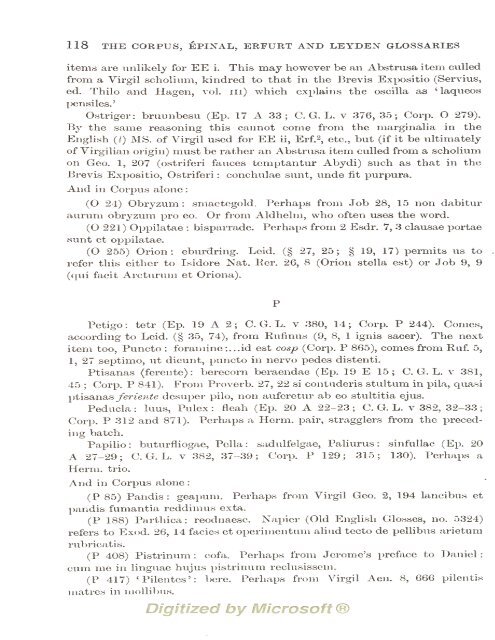the corpus, épinal, erfurt and leyden glossaries, viii - World eBook ...
the corpus, épinal, erfurt and leyden glossaries, viii - World eBook ...
the corpus, épinal, erfurt and leyden glossaries, viii - World eBook ...
You also want an ePaper? Increase the reach of your titles
YUMPU automatically turns print PDFs into web optimized ePapers that Google loves.
118 THE CORPUS, EPINAL, ERFURT AND LEYDEN GLOSSARIES<br />
items are unlikely for EE i. This may<br />
however be an Abstrusa item culled<br />
from a Virgil scholium, kindred to that in <strong>the</strong> Brevis Expositio (Servius,<br />
ed. Thilo <strong>and</strong> Hagen, vol. iii) which explains <strong>the</strong> oscilla as 'laqueos<br />
pensiles.'<br />
Ostriger: bruunbesu (Ep. 17 A 33; C. G. L. v 376, 35; Corp. 279).<br />
By <strong>the</strong> same reasoning this cannot come from <strong>the</strong> marginalia in <strong>the</strong><br />
English (0 MS. of Virgil used for EE ii, Erf.^, etc., but (if it be ultimately<br />
of Virgilian origin) must be ra<strong>the</strong>r an Abstrusa item culled from a scholium<br />
on Geo. 1, 207 (ostriferi fauces temptantur Abydi) such as that in <strong>the</strong><br />
Brevis Expositio, Ostriferi : conchulae sunt, unde fit purpura.<br />
And in Corpus alone :<br />
(0 24) : Obryzum smaetogold. Perhaps from Job 28, 15 non dabitur<br />
aurum obryzum pro eo. Or from Aldhelm, who often uses <strong>the</strong> word.<br />
(O 221) Oppilatae : bisparrade. Perhaps from 2 Esdr. 7, 3 clausae portae<br />
sunt et oppilatae.<br />
(0 255) Orion: eburdring. Leid. (§ 27, 25; § 19, 17) permits us to<br />
refer this ei<strong>the</strong>r to Isidore Nat. Rer. 26, 8 (Orion stella est) or Job 9, 9<br />
(qui facit Arcturum et Oriona).<br />
Petigo : tetr (Ep. 19 A 2 ; C. G. L. v 380, 14 ; Corp. P 244). Comes,<br />
according to Leid. (§ 35, 74), from Rufinus (9, 8, 1 ignis sacer).<br />
item too, Puncto :<br />
The next<br />
foramine :...id est cosp (Corp. P 865), comes from Ruf 5,<br />
1, 27 septimo, ut dicunt, puncto in nervo pedes distenti.<br />
Ptisanas (ferente): berecorn beraendae (Ep. 19 E 15; C. G. L. v 381,<br />
45 ; Corp. P 841). From Proverb. 27, 22 si contuderis stultum in pila, quasi<br />
ptisanas /enen^e desuper pilo, non auferetur ab eo stultitia ejus.<br />
Peducla : luus, Pulex : fleah (Ep. 20 A 22-23 ; C. G. L. v 382, 32-33 ;<br />
Corp. P 312 <strong>and</strong> 871). Perhaps a Herm. pair, stragglers from <strong>the</strong> preceding<br />
batch.<br />
Papilio: buturfliogae, Pella: sadulfelgae, Pahurus: sinfullae (Ep. 20<br />
A 27-29; C. G. L. v 382, 37-39; Corp. P 129; 315; 130). Perhaps a<br />
Herm. trio.<br />
And in Corpus alone :<br />
P<strong>and</strong>is :<br />
Perhaps from Virgil Geo. 2, 194 lancibus et<br />
(P 85) geapum.<br />
p<strong>and</strong>is fumantia reddimus exta.<br />
(P 188) Parthica: reodnaesc. Napier (Old English Glosses, no. 5324)<br />
refers to Exod. 26, 14 facias et operimentum aliud tecto de pellibus arietum<br />
rubricatis.<br />
(P 408) Pistrinum :<br />
cofa. Perhaps from Jerome's preface<br />
cum me in linguae hujus pistrinum reclusissem.<br />
to Daniel :<br />
(P 417) 'Pilentes': bere. Perhaps from Virgil Aen. 8, 666 pilentis<br />
matres in mollibus.

















